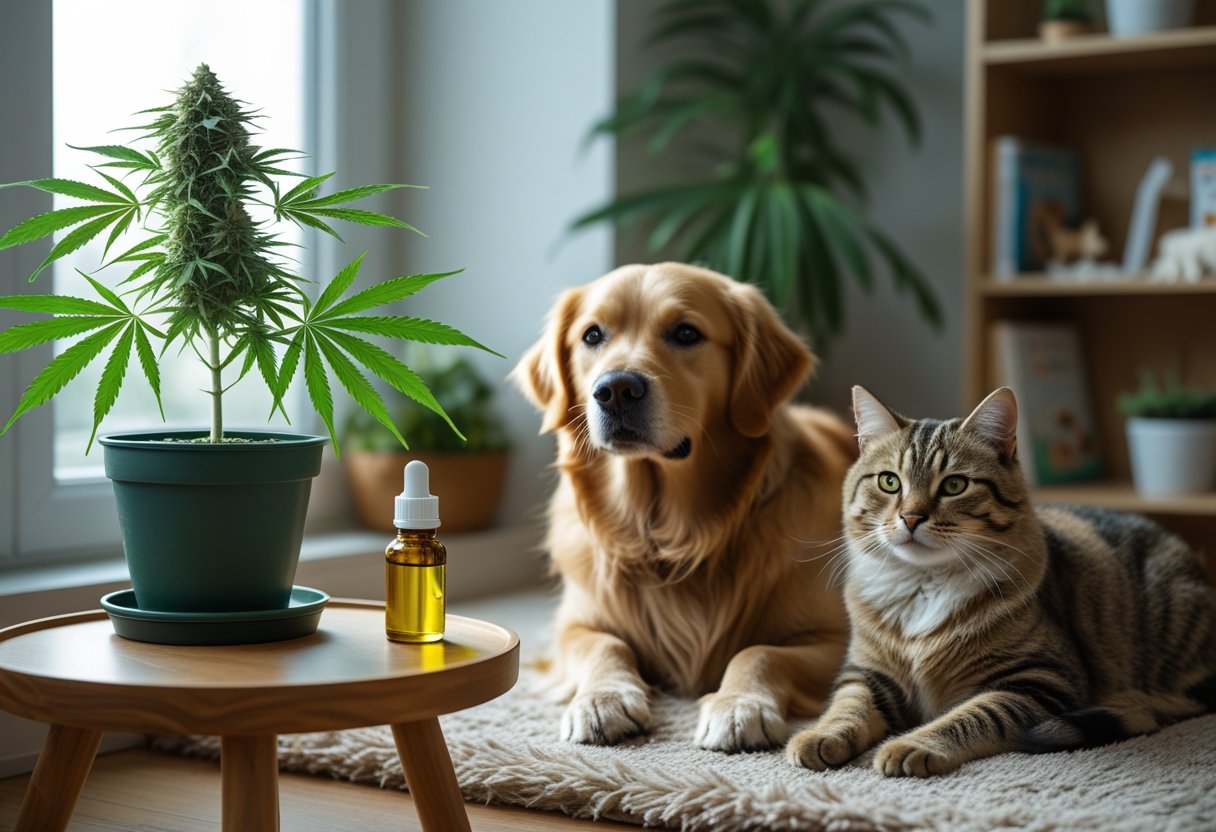

Many pet owners wonder if cannabis can help their animals and how safe it really is. Cannabis contains different compounds that may offer therapeutic benefits but also carry risks, so understanding these factors is essential before considering its use for pets. This guide sheds light on what cannabis is, how it affects pets, and what to watch out for.

The topic can be confusing because cannabis products vary widely in strength and ingredients. Some products might help with issues like anxiety or pain, but others can cause serious poisoning, especially in dogs. Knowing how to choose the right products and when to avoid them is key to keeping pets safe and healthy.
Because pets cannot speak for themselves, monitoring their reactions is important. This guide will help owners make informed decisions about cannabis use, ensuring their pets get the most benefit with the least risk.
Key Takeaways
- Cannabis has compounds that may help pets but must be used carefully.
- Some cannabis products can be harmful or toxic to pets.
- Choosing the right product and dosage is critical for pet safety.
Understanding Cannabis and Its Components

Cannabis contains many chemical compounds that interact with the body in specific ways. These compounds influence how animals feel, move, and react to pain or stress. Understanding these parts helps explain how cannabis can affect pets.
What Is Cannabis?
Cannabis is a plant that produces over 100 different compounds called cannabinoids. These substances interact with animals’ bodies and brains. The plant also contains other chemicals like terpenes and flavonoids, which can change its effects.
Cannabis has two main species: Cannabis sativa and Cannabis indica. Both have different levels of cannabinoids, which can influence their use. In recent years, cannabis has been studied for medical use in both humans and animals, but it must be used carefully.
Key Cannabinoids: THC and CBD
Two cannabinoids are most important: THC (tetrahydrocannabinol) and CBD (cannabidiol). THC is the compound that makes cannabis psychoactive, causing a “high” feeling. It can be toxic to pets at high doses, so caution is needed.
CBD does not cause a high and is studied for its potential health benefits. It may help with pain, anxiety, and inflammation in animals. Both THC and CBD interact differently with the body’s cannabinoid receptors, which affects their effects.
| Cannabinoid | Effect on Pets | Risks |
|---|---|---|
| THC | Psychoactive, can harm pets if overdosed | Toxicity, anxiety, lethargy |
| CBD | Non-psychoactive, potential therapeutic effects | Possible mild side effects |
Endocannabinoid System in Animals
Animals have an endocannabinoid system (ECS), a group of receptors and molecules that help regulate mood, pain, appetite, and immune response. The main receptors are CB1 and CB2.
The body produces natural cannabinoids like anandamide and 2-arachidonoylglycerol (2-AG) that bind to these receptors. Cannabis cannabinoids like THC and CBD mimic or influence these natural chemicals, changing how the system works.
Understanding the ECS is key to knowing how cannabis affects pets, including possible benefits and risks. However, the system varies among different species, so effects may not be the same for all animals.
For deeper information on cannabinoid therapies for animals, see Cannabis in veterinary medicine: cannabinoid therapies for animals.
Potential Benefits of Cannabis for Pets

Cannabis products, especially those containing cannabidiol (CBD), are being studied for their effects on pets. These products may help address conditions like stress, chronic pain, and seizures. Cannabis acts on specific receptors in the body that influence mood, pain, and neurological function.
Managing Anxiety and Stress
Many pets experience stress and anxiety from loud noises, separation, or changes in their environment. CBD has been found to affect the brain’s serotonin receptors, which help regulate mood and reduce anxiety. Some pet owners report calmer behavior in dogs and cats after using CBD products.
Stress in pets can cause symptoms like pacing, panting, or hiding. Using CBD may help reduce these behaviors by promoting relaxation without causing sedation. However, the exact doses and long-term effects are still under study, and veterinarians caution careful use to avoid side effects.
Chronic Pain Relief
Chronic pain is common in aging pets, particularly from arthritis. Cannabidiol interacts with the pet’s endocannabinoid system to reduce inflammation and alter how the brain processes pain signals. This can lead to relief without the side effects often caused by traditional pain medications.
Pets with arthritis or other long-term conditions may show improved mobility and less discomfort when given CBD. Studies with dogs have given doses like 180 mg orally without major side effects. Still, professional guidance is important to ensure safe and effective use.
Benefits of CBD for chronic pain:
- Reduces inflammation
- Lowers pain signals
- May improve joint function
- Fewer negative effects than opioids or NSAIDs
Support for Seizures
Seizures in pets can result from epilepsy or brain injury. Some studies suggest CBD may reduce the frequency and severity of seizures by stabilizing nerve activity in the brain. This makes it a potential option for pets that do not respond well to traditional anti-seizure drugs.
Pet owners have reported fewer seizures and improved quality of life after using CBD. However, research is ongoing to confirm these effects and establish proper dosing guidelines. Medical supervision is essential, as seizures require careful management.
Using cannabis products for medical purposes in pets involves understanding risks and benefits. While promising, more research is needed to fully prove safety and effectiveness.
Risks and Toxicities of Cannabis in Pets
Cannabis exposure in pets can lead to serious health problems. Different forms of cannabis, especially those with high THC, pose varying levels of risk. Understanding these dangers helps owners recognize when to seek veterinary care and avoid accidental poisoning.
Symptoms and Signs of Overdose
Pets exposed to cannabis often show clear signs of overdose. Common symptoms include lethargy, uncoordinated movements (ataxia), and excessive drooling. Some pets may experience vomiting, tremors, or an altered mental state like confusion or agitation.
Other signs are dilated pupils, low body temperature, and slow heart rate. In some cases, pets act disoriented and may have difficulty standing or walking.
Because cannabis products like edibles or oils can contain high THC levels, ingestion of these can cause stronger toxic effects. Not all pets react the same, but the severity of symptoms usually relates to the amount and type of cannabis ingested.
Short-Term and Long-Term Effects
Short-term effects of cannabis poisoning include loss of balance, poor coordination, and extreme sedation. Pets may also develop digestive upset or urinary incontinence. These effects often appear within hours of ingestion and can last for several hours to a day.
Long-term effects are less studied but may include memory issues and changes in behavior. Pets repeatedly exposed to THC might experience altered sleep patterns or increased anxiety.
Unlike humans, pets lack tolerance for THC. This increases their risk of unwanted side effects like headaches or neurological issues after cannabis exposure.
Understanding Cannabis Toxicities
THC (tetrahydrocannabinol) is the main toxic agent in cannabis for pets. Products containing high concentrations, such as butters or oils, carry the greatest risk.
Toxicity varies by species, size, and overall health of the pet. Dogs are the most commonly affected animals. The toxic dose can be very small, so even minor exposure can lead to symptoms.
Veterinarians often recommend quick treatment to prevent absorption, including inducing vomiting and providing supportive care. Recognizing the type of cannabis product involved helps guide treatment decisions.
For more detailed information on cannabis toxicosis in pets, see this survey of veterinarians in North America.
Cannabis Products and Formulations for Pets
Cannabis products for pets come in various forms designed to deliver CBD or other cannabinoids safely. Each type has specific uses, dosing methods, and storage needs that affect their effectiveness and safety.
CBD Oil and Tinctures
CBD oil and tinctures are the most common cannabis products for pets. These liquids contain measured amounts of CBD, sometimes with small amounts of THC, but mostly focus on CBD for safety. Owners can give these directly by mouth or add them to food.
Tinctures offer precise dosing, making it easier to control how much CBD a pet receives. The oils are usually extracted from hemp and formulated to ensure consistent potency. The dosage depends on the pet’s weight and condition, so careful measurement is important to avoid overdosing.
Edibles and Ointments
Cannabis edibles for pets often come as treats infused with CBD or other cannabinoids. These are convenient for pets that refuse oils or tinctures. However, the level of cannabinoids in edibles can vary, so owners should check product labels carefully.
Ointments are topical cannabis products applied to the pet’s skin for localized relief, such as sore joints or skin irritation. They do not enter the bloodstream directly, so they are less likely to cause systemic effects.
Selection and Storage Tips
When selecting cannabis products for pets, check the potency in milligrams of CBD and THC. Products labeled clearly with ingredient amounts are safer. Avoid products with unknown or untested ingredients.
Store cannabis products in an airtight container away from light, heat, and moisture to maintain their strength and freshness. Proper storage helps prevent degradation of the cannabinoids. Keep them out of reach of pets and children.
For best safety, choose products made specifically for pets rather than using human cannabis products, which may contain harmful ingredients or higher THC levels. For more detailed guidance on product selection and dosing, see this article on product selection and dosing considerations.
Selecting the Right Cannabis Products for Pets
When choosing cannabis products for pets, it is important to focus on the specific needs related to their health. Factors like the cannabis strain and the product’s safety must be carefully considered to ensure effective and risk-free use.
Evaluating Cannabis Strains
Different cannabis strains have distinct effects, largely based on their cannabinoid and terpene profiles. For pets, strains high in CBD and low in THC are preferred because CBD can help with pain, anxiety, and inflammation without causing psychoactive effects.
Indica strains tend to be more calming, which may benefit pets with anxiety or insomnia. Sativa strains, often more stimulating, are less common for pet use. It is crucial to avoid strains high in THC, as this can be toxic to animals.
Pet owners should look for products clearly listing cannabinoid content and strain information to make an informed choice based on the animal’s medical needs.
Choosing Safe and Effective Products
Safety is the top priority when selecting cannabis products for pets. Products should be third-party tested to confirm they are free from heavy metals, pesticides, and harmful additives.
Dosage guidelines should be clearly stated, and products designed specifically for pets are recommended rather than human products. Oils, tinctures, and treats made for animals usually provide precise dosing and better absorption.
Checking for reputable certifications or seals of quality can help pet owners avoid low-quality or unsafe products. Monitoring the pet’s response and consulting a veterinarian knowledgeable about cannabinoids is important to adjust dosing safely. For more on selecting safe products, visit this guide on cannabinoid therapies for animals.

